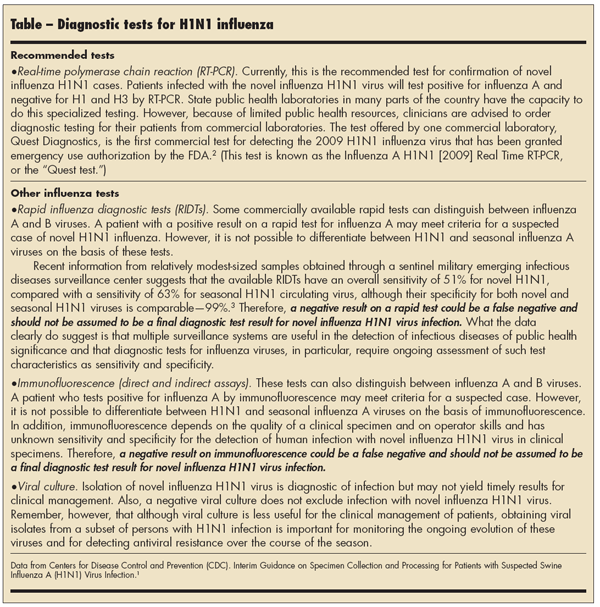Diagnostic Testing for H1N1 Flu: When and How
Confirming the presence of the H1N1 influenza virus in patients with suspected infection is critical to public health efforts to track, study, and contain the disease-and to the ability of clinicians to provide optimal management. Appropriate diagnostic testing is key to this process.
Confirming the presence of the H1N1 influenza virus in patients with suspected infection is critical to public health efforts to track, study, and contain the disease-and to the ability of clinicians to provide optimal management. Appropriate diagnostic testing is key to this process.
WHEN TO TEST
Keep in mind that the probability of patients with influenza-like illness (ILI) having actual influenza virus infection depends largely on the amount of influenza activity in the community at the time. In a typical influenza season, only about 15% of patients who present with ILI actually have influenza; the remainder have illness caused by a variety of other pathogens. However, in the summer of 2009, the vast majority of ILI-associated viruses circulating in North America were confirmed to be H1N1 influenza. Thus, current recommendations are to treat empirically with appropriate antiviral drugs persons who present with moderately severe ILI, rather than basing therapeutic management on test results, which could delay timely intervention.
However, public health officials also recommend remaining vigilant concerning new trends in H1N1 spread, mortality, and drug resistance, and continuing to assess the burden of disease. Thus, limited testing is recommended for the following specific groups:
•Persons admitted to the hospital who are pregnant or who have life-threatening illness that suggests influenza infection.
•Persons who appear to be part of influenza outbreaks in institutional group settings (eg, schools, day-care centers, nursing homes, group residential facilities, church groups).
•Persons cared for in practices participating in surveillance activities.
HOW TO TEST
Because of viral shedding patterns, specimens should be collected at the earliest opportunity after symptoms begin in order to maximize yield.1 Specimens can include those from nasopharyngeal swab, nasal aspirate, or nasopharyngeal swab combined with oropharyngeal swab. Alternatively, a nasal swab specimen or an oropharyngeal swab specimen is acceptable if the nasopharynx cannot be accessed. A swab specimen from the anterior nares-for example, a specimen such as is typically obtained to test for methicillin-resistant Staphylococcus aureus-is not appropriate. In mechanically ventilated patients, endotracheal aspirates could also be collected. Sputum samples may be useful, and if bronchoscopy is needed, a bronchoalveolar lavage specimen should be obtained. If at all possible, obtain at least 3 respiratory specimens.
Diagnosis of H1N1 influenza is best made by real-time polymerase chain reaction (see Table). Therefore, it is important to use the proper type of swab when obtaining specimens for H1N1 testing. Use swabs with synthetic tips (Dacron or polyester) and with either an aluminum or plastic shaft. Other types of swabs (swabs with cotton tips, calcium alginate swabs, swabs with wooden shafts) are not acceptable because they will interfere with molecular tests.
For guidance on the proper technique for obtaining nasopharyngeal specimens, see the short online video, "Collection of Nasopharyngeal Specimens with the Swab Technique," at the New England Journal of Medicine online H1N1 Influenza Center (http://content.nejm.org/cgi/content/full/NEJMe0903992/DC1).
If a patient has predominantly diarrheal symptoms, a stool specimen may also be obtained; this should be clearly labeled to be processed for H1N1 testing.
Store and transport specimens in vials that contain about 1 to 3 mL of viral transport medium (VTM). To ready VTM specimens for transport to a processing center, immediately place them on ice or in a refrigerator (at about 4°C [39.2°F]); do not put them in a freezer. Further information on the packaging and shipping of specimens is provided in detail on the CDC Web site (http://www.cdc.gov/h1n1flu/specimencollection.htm).
The advantages and limitations of various diagnostic tests are listed in the Table. For further information about available testing for H1N1 influenza virus in your area, contact your local hospital laboratory, hospital infection control staff, or local health department.

References:
REFERENCES:
1.
Centers for Disease Control and Prevention (CDC). Interim Guidance on Specimen Collection and Processing for Patients with Suspected Swine Influenza A (H1N1) Virus Infection.
http://www.cdc.gov/h1n1flu/specimencollection.htm
. Accessed August 21, 2009.
2.
2009 H1N1 influenza virus testing.
http://www.questdiagnostics.com/2009H1N1/
. Accessed August 21, 2009.
3.
Faix DJ, Sherman SS, Waterman SH. Rapid-test sensitivity for novel swine-origin influenza A (H1N1) virus in humans.
N Engl J Med.
2009;361:728-729.